Top 13 Plants Perfectly Suited for North-Facing Windows
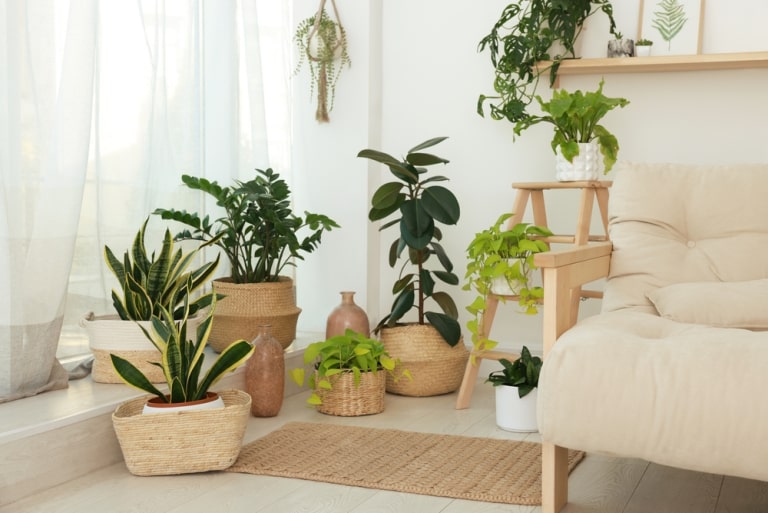
So you’re looking to introduce some greenery into your home but worried about your plants not getting enough sunlight?
Not to worry, you’re not alone. Many gardeners only have north-facing windows that receive little direct sunlight. Fortunately, you don’t have to sacrifice your desire for plants just because of how your home faces.
There are plenty of houseplants that thrive in minimal sunlight. With the right plant choices, you can create an urban jungle in any room in your house.
We’ve rounded up 13 houseplants for north-facing windows. From sturdy ZZ plants to giant Monsteras, you’ll find something that fits your preferences and space. So, let’s dive in.
Why Are North-Facing Windows Challenging for Plants?
North-facing windows receive minimal direct sunlight throughout the day. That’s why plants that require a decent amount of direct sunlight don’t do well in such windows.
Generally speaking, north-facing windows aren’t suitable for sun-loving plants for the following reasons:
- Duration of sunlight exposure: North-facing windows get around two hours of direct sunlight throughout the day, which isn’t sufficient for many plants
- Quality of light: Light from north-facing windows is often cooler and bluer than light from other windows. This isn’t optimal for plants that prefer warmer light.
- Intensity of sunlight: Most north-facing windows receive indirect sunlight, which is softer and cooler than light received by east or west-facing windows
Still, this doesn’t mean it’s impossible to place your plants near north-facing windows.
In fact, many plants thrive best in low-light conditions, such as snake plants, ferns, pothos, philodendrons, and many more.
13 Best Plants for North-Facing Window
North-facing windows can be challenging for some plants as they don’t provide direct sunlight. But with the right plant choices, you can have an indoor garden in front of any window in your home.
Here are the 13 best plants for north-facing windows:
1. Golden Pothos (Epipremnum Aureum)
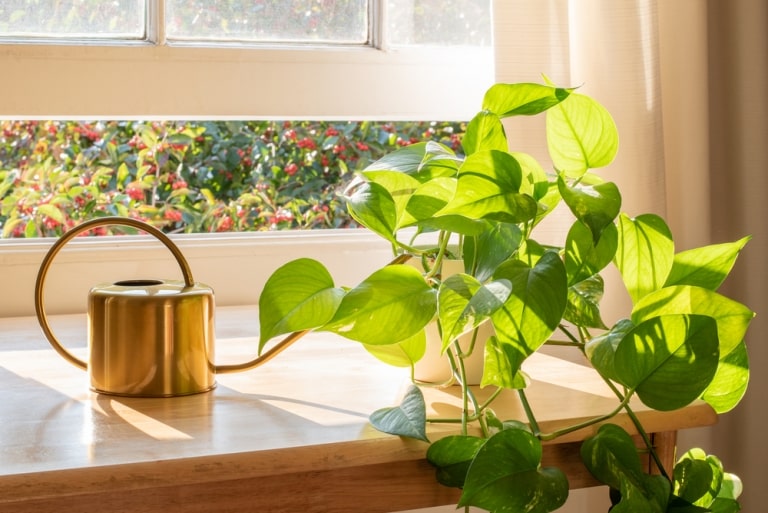
Known for its trailing vines and stunning heart-shaped leaves, the golden pothos is a beautiful, versatile houseplant that grows best in low light.
The Devil’s ivy plant is also low-maintenance, making it a perfect option for kids and novice plant owners.
Thanks to its trailing nature, you can grow pothos in various ways. For example, you can hang it from the pot or a shelf and enjoy the rambling vines. If you have a trellis near your north-facing windows, you can train your pothos up the trellis for a tropical vibe.
Light requirements
Pothos enjoy indirect sunlight but do very well in low and artificial light. It’s a decent option for north-facing windows.
Care Tips
- Water only when the soil feels dry
- Place in indirect light if possible; the plant tolerates low light but may lose some vegetation
- Plant in a well-draining soil mix that contains ingredients such as perlite and lava rocks for better aeration
2. Snake Plant (Dracaena Trifasciata)
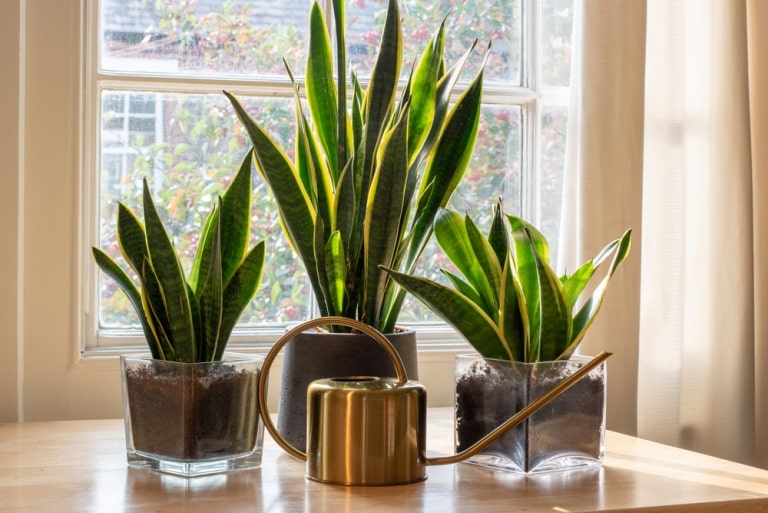
Known as St. George’s sword, mother-in-law’s tongue, and viper’s bowstring hemp, Snake plants are among the best plants to grow in low light. The snake plant will surely turn heads with its upright, sword-like leaves.
On top of that, snake plants thrive on neglect; they hate to be overwatered and can also tolerate low-light conditions.
There are many species of snake plants, but the most popular one for gardening is the Sansevieria trifasciata. If you want something unique, you can opt for other species.
The Moonglow, for example, has a distinctive, silvery green color and doesn’t have stripes like other snake plants. The Twist “Sansevieria trifasciata “ species has unique horizontally striped twisted leaves.
Light Requirements
Snake plants thrive best in bright, indirect sunlight but still do well in lower light conditions. So, no matter how much light your north-facing window gets, your snake plant won’t complain.
Care Tips
- Water when soil is almost completely dry
- Place away from the windows during the winter season
- Reduce the watering in winter to only once every one or two months
3. ZZ Plant (Zamioculcas Zamiifolia)
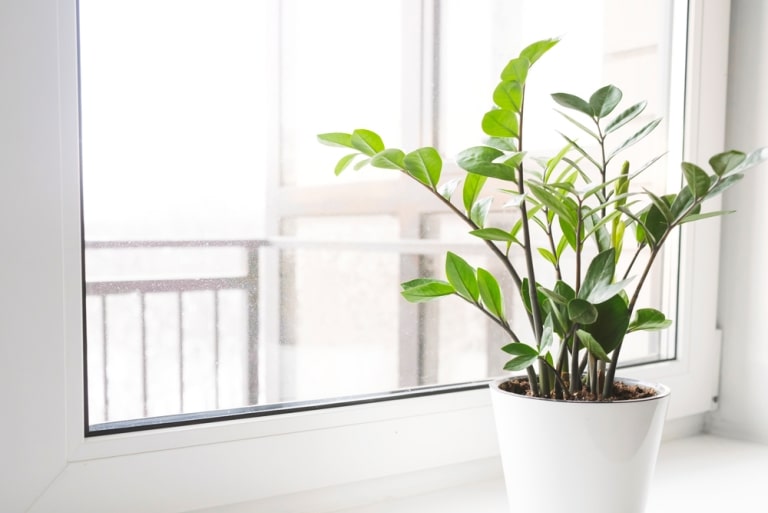
ZZ plants are another decent option for north-facing windows. Scientifically known as Zamioculcas Zamiifolia, these succulents have gained popularity for their tolerance to harsh conditions.
They withstand low light, inconsistent watering, and even extended periods of drought. As such, they work well when placed near north-facing windows that don’t get much sunlight throughout the day.
Even though ZZ plants are usually grown for ornamental purposes, they do a great job of purifying room air creating a healthier home/work environment.
With their glossy dark leaves and upright stems, ZZ plants can grow up to five feet tall and five feet wide; they make a statement in any room or office.
Light Requirements
ZZ plants are slow growers; they don’t need much sunlight or water to reach their full potential. They grow best in indirect sunlight but survive extremely low-light conditions.
However, small amounts of sunlight can scorch the leaves.
Care Tips
- Water only once every two or three weeks, allowing the soil to completely dry between waterings.
- Keep your ZZ plant away from intense direct sunlight.
- Repot when the rhizomes start pressing up against the edges of the pot.
4. Peace Lily (Spathiphyllum Wallisii)

If you want to incorporate flowering plants into your space, consider the Peace Lily. It’s a popular houseplant known for its easy care requirements and striking appearance. The Peace Lily has glossy dark green leaves that grow upright and can reach up to 4 feet tall, depending on the species.
The most unique feature of the Peace Lily is its elegant white blooms that resemble white flags; it symbolizes peace and welfare.
Additionally, Peace Lilies can tolerate harsh conditions such as low light, so they’re suitable for north-facing windows. They also do a great job of telling you they need water as they dramatically droop when not watered but will quickly perk up after watering.
Light Requirements
Peace Lilies are well-suited for low-light conditions, making them a great choice for north-facing windows.
Care Tips
- Wipe the leaves regularly with a damp cloth
- Water when the top inch of soil is dry
- Divide and prune your Peace Lily plant to keep it blooming
5. Heart-leaf Philodendron (Philodendron Scandens)

Philodendrons are a popular and diverse group of houseplants notorious for their lush foliage. There are many species of Philodendrons, including the heart-leaf Philodendron, which is named after its distinctive smooth heart-shaped leaves.
As the Philodendrons mature, they grow long trailing vines that can either climb up trellises and moss poles or cascade from hanging baskets. This makes the heart-leaf Philodendron a versatile and ornamental plant that can be displayed in various ways to suit every space.
Moreover, Philodendrons are low-maintenance plants, and they adapt well to various light settings, including low-light areas. They also don’t require much water, so they’re suitable for starters and kids.
Light Requirements
Philodendrons grow well in low-light or partial shade, which is ideal for north-facing windows. Note that you shouldn’t place Philodendrons under direct sunlight as their leaves can easily scorch.
Care Tips
- Allow the soil to completely dry between waterings to avoid overwatering issues such as root rot.
- Place in indirect sunlight, as direct sunlight can easily burn the leaves.
- Pinch out the stems regularly to keep your Philodendrons bushy.
6. Monstera Deliciosa (Swiss Cheese Plant)
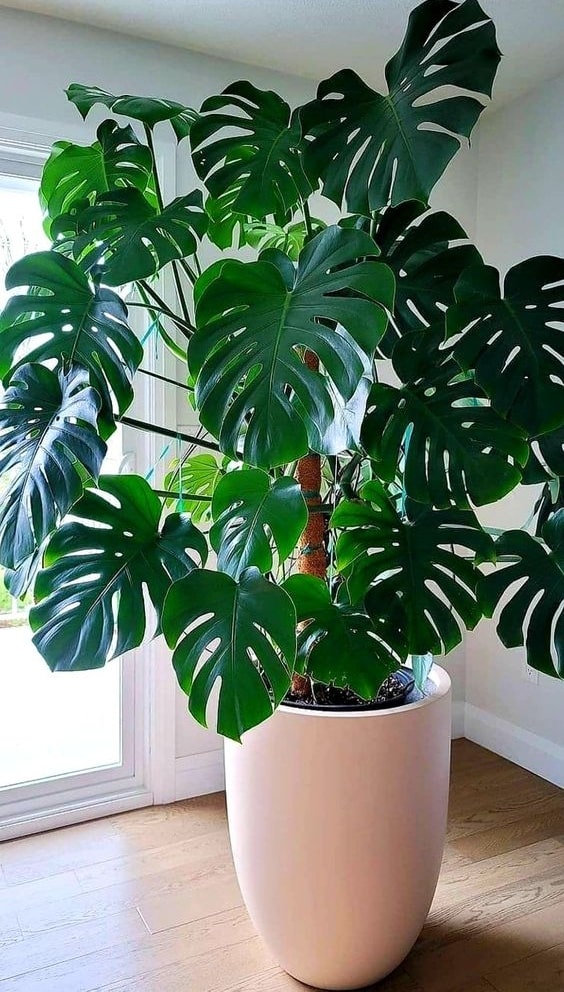
Speaking about resilient and ornamental houseplants, we can’t forget to mention the Monstera Deliciosa. This giant tropical plant has gained immense popularity over the past few years for its stunning perforated leaves, low maintenance, and unique appearance.
As the name Swiss Cheese plant suggests, Monsteras have large fenestrated leaves that resemble Swiss cheese slices. The plant develops more fenestrations as it matures, giving it an eye-catching appearance that can make a statement in your house or office.
Monsteras are also popular because of their ability to climb on support trellis, moss poles, and wooden stakes. With proper support, Monsteras can reach up to 15 feet tall!
As a low-maintenance plant, Monstera Deliciosa does well in most households as it requires indirect sunlight. That means it’s an ideal choice for north-facing windows.
Light Requirements
Monsteras thrive best in indirect bright light and don’t like sitting in direct sunlight for too long as the leaves may burn.
Care Tips
- Water only when the top two inches of the soil is completely dry.
- Provide a humid environment using a fine mister or a humidifier
- Opt for well-draining soil mixes that contain perlite, pebbles, and organic matter
7. Phalaenopsis (Moth Orchid)
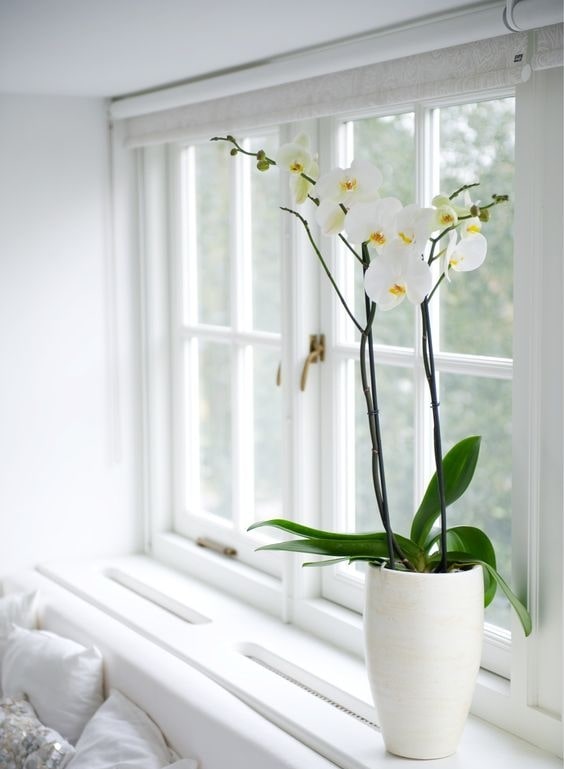
The Phalaenopsis, also known as the Moth Orchid, is an ornamental flowering houseplant cherished for its stunning blooms and easy maintenance.
The Moth Orchid features graceful flowers resembling fluttering moths. Moreover, the blooms come in various colors, including shades of pink, white, purple, red, and yellow. Some Phaleonopis orchids even have fragrant flowers.
Phalaenopsis orchids are relatively low-maintenance plants. They require indirect bright light and grow well in average room temperatures (65 and 85 degrees Fahrenheit), so they do well when planted next to north-facing windows.
However, Phalaenopsis orchids need much more light to develop bloom spikes. That means, at some point, you might need to place your plant near a west or east-facing window.
Light Requirements
Phalaenopsis Orchids need bright indirect sunlight to thrive. Placing these plants in direct sunlight for too long can harm the foliage and cause premature bloom drop.
Care Tips
- Phalaenopsis Orchids need higher humidity levels; use a humidifier or place your plant in a tray of pebbles and water in winter.
- Allow the soil to dry between waterings, and don’t let the plant sit in water for long periods.
- Cut the wilting flowers to encourage newer blossoms.
8. Bird’s Nest Fern (Asplenium Nidus)

Bird’s nest ferns, also known as Asplenium Nidus, are epiphytic plants, meaning they grow on the surface of other plants in their native habitat. These ferns feature rosette-shaped fonds resembling a bird’s nest, hence its common name.
Most ferns grow feathery leaflets, but the Asplenium Nidus has sleek, lance-shaped fronds that may develop ripples when provided with ample light.
Despite their delicate nature, bird’s nest ferns don’t require much maintenance. They grow well in indirect, bright light and demand watering only once weekly.
Light Requirements
Bird’s nest ferns demand bright or medium indirect light to thrive. However, they do well in lower light conditions since they’re used to growing in partial shade and dappled light in their natural habitat.
Care Tips
- Allow the topsoil to dry slightly between waterings; this plant demands adequate moisture levels but hates to stay in water for too long.
- Use a well-draining soil mix that retains some moisture.
- Remove yellowed or dead fronds to encourage the growth of new ones.
9. Rex Begonia (Begonia Rex-Cultorum)
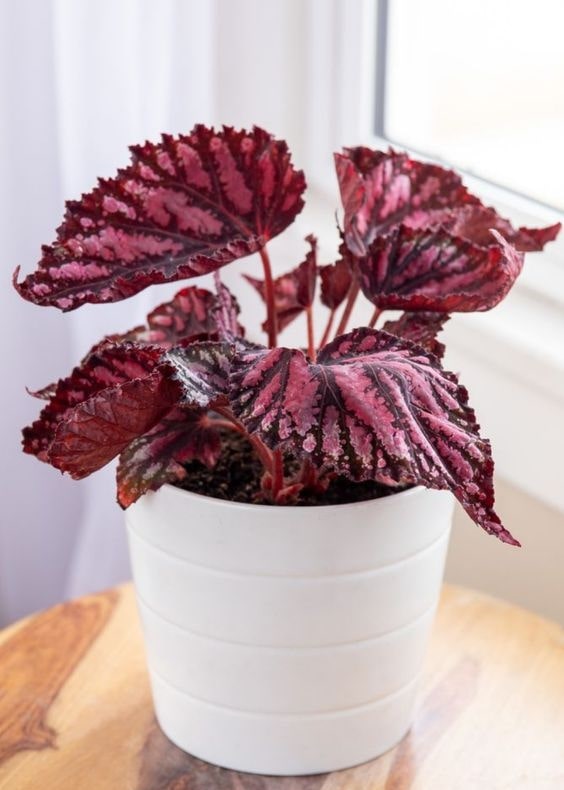
The Rex Begonia, also known as painted-leaf Begonia, is a stunning and popular plant that’s notorious for its vibrant and colorful foliage. This semi-tropical plant features huge variegated
leaves that come in a wide array of colors, including green, red, purple, and silver.
In their native habitat, Rex Begonias thrive in shady and partially shady jungles; they’re considered tropical plants. However, you can easily plant a Rex Begonia indoors as long as you place it in a shady location, like near a north-facing window.
Light Requirements
Rex Begonias thrive in bright, indirect sunlight, so placing them near north-facing windows will do the trick. Remember that you should never place your Rex Begonia in direct sunlight, as the leaves can easily scorch.
Care Tips
- Plant in a porous soil mix and a relatively shallow pot.
- Provide enough moisture for the plant, but avoid overwatering.
- Rotate the plant frequently so that it receives an equal amount of light on every side.
10. Bromeliacea (Bromeliads)

Bromeliads are a diverse group of plants that come in endless sizes, shapes, and colors, making them favorites among plant enthusiasts.
Even though there are over 3000 species of bromeliads, most of them do well in low-light settings, so they’re suitable for north-facing windows.
Bromeliads range from small, compact plants to larger ones with long arching leaves. These plants are notorious for their distinctive rosette-shaped leaves that resemble a central cup structure that collects water.
If you wish to incorporate a bromeliad near your north-facing window, make sure to opt for bromeliads with darker colors, as they are more suited for north-facing windows than other types. The Bromeliaceae Aechmea and Bromeliaceae Guzmania are both great choices.
Light Requirements
Bromeliads like to sit in bright, indirect sunlight, and they can easily grow indoors or outdoors. Just place your plant away from direct, intense sunlight to protect the leaves.
Care Tips
- Plant in a fast-draining soil mix.
- Water only when the top two inches of soil is dry.
- Use a humidifier or make a humidity tray in winter, as bromeliads require 60% humidity.
11. Adiantum (Maidenhair Fern)
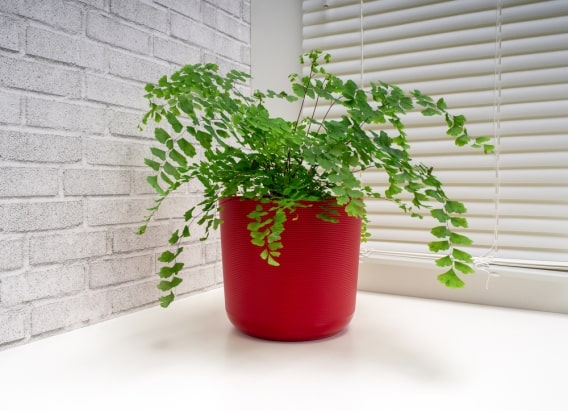
The Adiantum, also known as the Maidenhair Fern, is a delicate and elegant houseplant most famous for its fan-shaped leaves and compact size.
The maidenhair fern might not be the easiest plant to care for, and that’s because its leaves can easily go brown in unfavorable conditions.
But still, Adiantums are a good choice if you have a north-facing window since they demand bright, indirect sunlight that mimics their natural habitat.
Light Requirements
Adiantums thrive in indirect sunlight and moderate temperatures. Avoid direct sunlight as it burns the foliage.
Care Tips
- Water your Adiantum regularly, but let the soil dry between waterings.
- Mist the leaves regularly, especially if you live in a dry climate.
- Repot every year or two into a well-draining soil mix.
12. Fittonia (Nerve Plant)
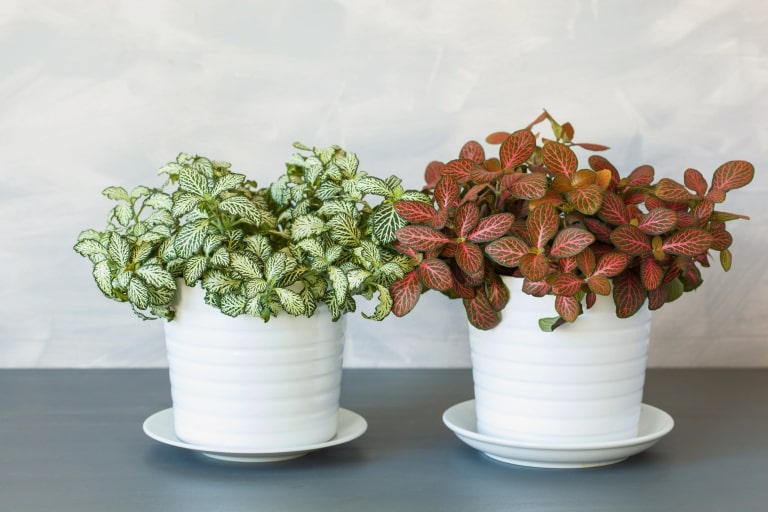
Fittonias are another decent option to grow near north-facing windows. They’re lovely houseplants that have intricately patterned leaves that resemble the appearance of nerves.
One thing we like about Fittonias is that they come in various vibrant colors. Moreover, the color combination of the leaf blades and veins can vary depending on the type of Fittonia you’re growing.
For example, pink Fittonias feature pink veins and green blades. Meanwhile, the Fortissimo species have red veins and light green leaves.
Light Requirements
Fittonias generally prefer to grow in bright, indirect sunlight and hot, humid weather. That’s why they’re well-suited for north-facing windows, as they get the right amount of light without exposure to direct sunlight.
Care Tips
- Water when 50% of the soil is dry.
- Place in the bathroom or kitchen as Fittonias need high humidity.
- Keep your Fittonias at a temperature range of 60-70 degrees Fahrenheit, and keep them away from chilly breezes.
13. Aglaonema Modestum (Chinese Evergreen)
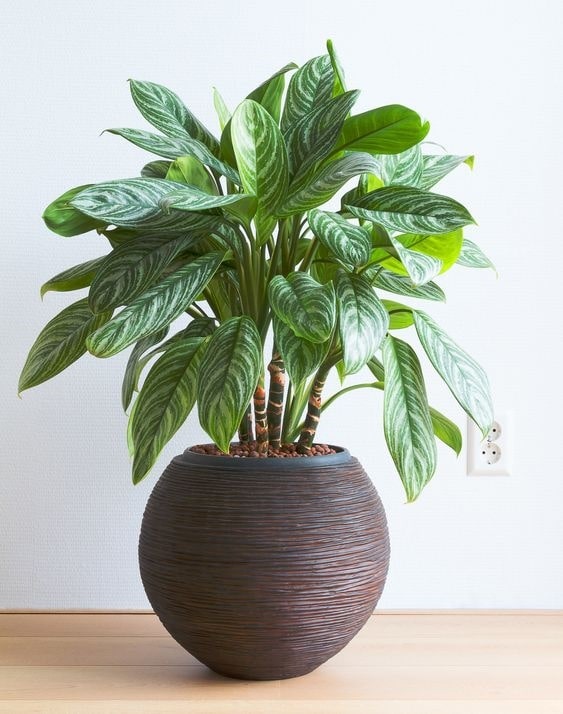
If you’re looking for sturdy plants that tolerate low-light conditions, the Chinese Evergreen should be on your list. It’s a popular houseplant that’s most famous for its attractive foliages and stunning appearance.
The Chinese Evergreen features broad, lance-shaped leaves that come in various colors, including green, pink, and red.
In general, Aglaonemas are low-maintenance plants. They’re suitable for kids, beginners, and busy plant owners. They also can tolerate different light conditions, including low and indirect sunlight, so they’re suitable for areas with north-facing windows.
Light Requirements
Most Aglaonemas prefer low to medium indirect sunlight. However, the variegated species might need more time under direct sunlight to grow better.
Care Tips
- Water regularly, but let the soil dry between waterings to avoid root rot issues.
- Don’t keep your Aglaonema in temperatures below 70 degrees Fahrenheit.
- Use liquid fertilizer or slow-release pellets at the beginning and the end of the growing season.
Wrapping Up
There you have it; 13 different plants for north-facing windows. Remember that you don’t need to ignore your passion for planting just because of the way your home faces.
If you choose the right type of greenery, you can turn the most light-challenged areas in your home into lively gardens.





